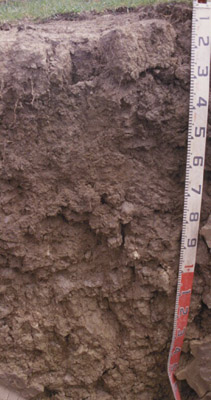SFS20
Location: East of Lake Weering
Aust. Soil Class.: Vertic (& Calcic), Mottled-Mesonatric, Black SODOSOL
General Landscape Description: Level Plain.
Site Description: Grazing paddock
Element: Plain – potentially a paleo lake bed or high level swamp
Slope: 0-1%
Aspect: 0
Geology: Quaternary - Newer Volcanics
 SFS 20 |
Soil Profile Morphology:
| Surface Soil |  SFS 20 | ||
| A1 | 0-5 cm | Dark greyish brown (10YR4/2); fine sandy clay loam; fine crumb structure; pH 5.4; clear boundary to intermittent A2 or B21t horizons: | |
| A2 | 5-30 cm | Intermittent hoizon ranging from <0.5 cm to 25 cm thickness; conspicuously bleached (10YR7/1 drt); clay loam, fine sandy; minor very fine to fine (2-5 mm) buckshot and well rounded quartz of same size range; hard set massive (but reflecting cracking pattern of B21 prisms below); rusty root channels mottling; pH 5.4; abrupt change to: | |
| Subsoil | |||
| B21t | 5/30 - 40 cm | Very dark grey (10YR 3/1) with (10%) fine yellowish brown (10YR5/8) mottles common; heavy clay; extremely coarse (25-30 cm) prismatic structure; very strong consistence (dry); extremely dispersive (totally dispersed in 5 minutes); pH 7.3; clear change to: | |
| B22 | 40-70 cm | Brown (10YR5/3) with many (>30%) medium sized yellowish brown (10YR 5/8) mottles; heavy clay; less definite structure than B21 above or B23 below, sticky consistence at time of sampling; pH 8.6; gradual change to: | |
| B23ss | 70-100 cm | Light yellowish brown (2.5Y 6/4); heavy clay; many think lenticular peds; slightly calcareous (audible effervescence with dilute acid); pH 9.4; gradual change to: | |
| B24k | 100-200 cm | Light olive brown (2.5Y 5/4) ; heavy clay; thick coarse lenticular and prismatic structure; fine (1-3 mm) buckshot throughout the matrix; very highly calcareous (large masses of soft carbonate and many calcareous soft segregations); pH 9.4; gradual change to: | |
| B25ss | 200 + cm | Greyish brown (2.5Y 5/2) with (10%) fine to medium brownish yellow (10YR 6/8) mottles common and fine black lustrous manganiferous coastings on some ped faces; strongly pedal, frequent very lage (up to 1 m) slickensides; pH 8.7. | |
Key Profile Features:
- Strong texture contrast between surface (A) horizons and subsoil (B21) horizons.
- Conspicuously bleached surface (A2) horizon.
Soil Profile Characteristics:
pH | Salinity Rating | |||
Surface (A1 horizon) | Strongly Acid | Low | Non-Sodic | None |
Subsoil (B21 horizon) | Slightly Alkaline | Low | Strongly Sodic | Complete |
Deeper subsoil (at 140-160 cm) | Very Strongly Alkaline | High | Strongly Sodic | Slight1 |
 |
Horizon | Horizon Depth (cm) | pH (water) | pH (CaCl2) | EC dS/m | NaCl | Exchangeable Cations | |||
Ca | Mg | K | Na | ||||||
meq/100g | |||||||||
A1 | 0-5 | 5.4 | 4.7 | 0.27 | 0.03 | 3.3 | 2.8 | 1.2 | 0.6 |
A2 | 5-15 | 5.4 | 4.5 | 0.12 | 1.6 | 1.8 | 0.27 | 0.88 | |
B21 | 20-30 | 7.3 | 6.5 | 0.33 | 0.03 | 4.4 | 13 | 1.6 | 6.1 |
B22 | 40-50 | 8.6 | 8.0 | 0.56 | 0.05 | 4.3 | 17 | 1.8 | 9.5 |
B23 | 80-110 | 9.4 | 8.5 | 0.37 | 0.06 | 3.3 | 16 | 1.7 | 12 |
B24 | 140-160 | 9.4 | 8.5 | 0.51 | 0.20 | 3.4 | 17 | 1.4 | 12 |
B25 | 280+ | 8.7 | 7.9 | 0.46 | |||||
Horizon | Horizon Depth (cm) | Exchangeable Aluminium mg/kg | Exchangeable Acidity meq/100g | Field Capacity pF2.5 | Wilting Point pF4.2 | Coarse Sand (0.2-2.0 mm) | Fine Sand (0.02-0.2 mm) | Silt (0.002-0.02 mm) | Clay (<0.002 mm) |
A1 | 0-5 | 14 | 15 | 37.9 | 15.9 | 11.3 | 35.3 | 18.5 | 22.5 |
A2 | 5-15 | 37 | 7.6 | 23.2 | 7.3 | 17.7 | 39.6 | 18.5 | 19.0 |
B21 | 20-30 | 44.7 | 26.4 | 6.2 | 17.2 | 10.0 | 61.5 | ||
B22 | 40-50 | 47.5 | 28.7 | 5.5 | 18.9 | 12.5 | 58.5 | ||
B23 | 80-110 | 47.3 | 26.3 | 7.6 | 20.7 | 19.0 | 47.5 | ||
B24 | 140-160 | 46.8 | 26.1 | ||||||
B25 | 280+ |
Management Considerations:
- Plant available water capacity (PAWC) is considered to be very low (estimated at 29 mm) in the upper 20 cm of this soil profile. Effective rooting depth (ERD) is restricted to 20 cm due to due to the higly sodic (ESP>20) subsoil.
- Acid topsoil (A1 and A2) and high exchangeable aluminium will limit plant growth in this soil but this can be readily remedied with lime. The subsoil is extremely sodic (ESP = 24-35%) and highly dispersive. This soil is extremely prone to waterlogging. Subsoil conditions are unfavourable for root growth because of the sodic swelling nature of the clay and the extremely coarse structure. Gypsum application will improve subsoil permeability but the coarse structure will remain a limitation. Cropping this soil would not have good prospects without major soil improvement (e.g. use of raised beds, lime and gypsum application, controlled traffic).
- Profile described by Richard MacEwan & Mark Imhof, June 2000.


